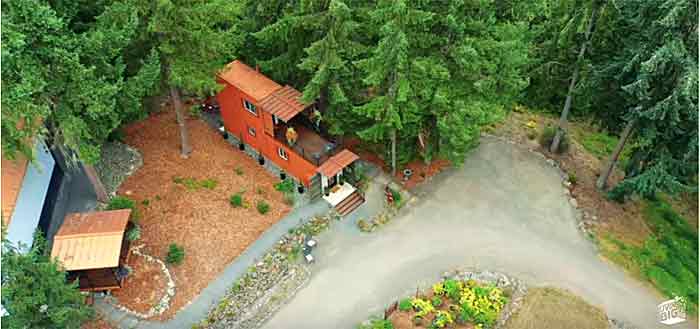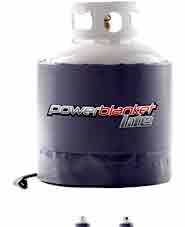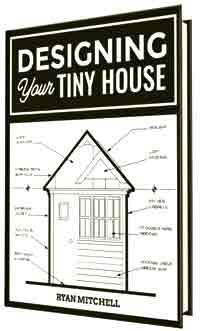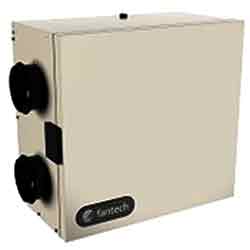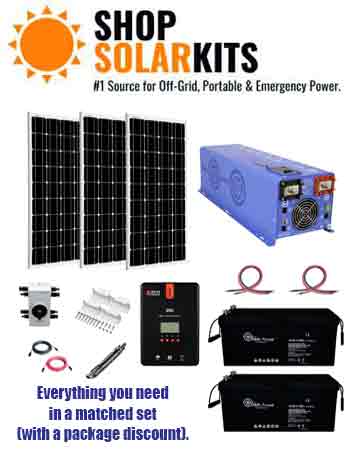Infrastructure for Your Tiny Home Build
It is often counseled that you need to have a place to put your tiny home before you build. Finding the right property to serve your intentions, lifestyle choices, and funding can be a daunting task. But zoning and building codes on your property will dictate at least two essential factors: what type of infrastructure you will be able to build as well as what you will be required to build.
There are a myriad of questions you’ll need to answer before you even begin the building process. On this page we’ll simply touch on the basics, but we’ll provide links to our other pages, as well as showcasing some terrific books with all of the information you’ll need.
For example, the very process of going tiny encompasses the big questions: who, what, when, where, why, and how?
Do you need to live near your aging parents to care for them? Can you place your tiny abode in their yard and connect to their sewer, water, and electric? Are you seeking an “off-grid” experience depending on solar panels, composting, and recycled rainwater? Do you like city life or county quiet?
It could be a costly mistake to build your tiny house with a composting toilet and then find out that the county you want to live in doesn’t allow them. Retro-fitting plumbing is difficult, time consuming, and expensive. Have you looked into the expense and requirements of putting in a septic system?
Are you really the kind of person who can “live off the land?” Do you have the expertise and grit it takes to live like that? Does your spouse? If you are married with a family, you must consider your spouse’s feelings and the welfare of your children above your own desires. Alaska seems like a nice place to me, but my wife won’t even watch TV shows about it. We won’t be moving to Alaska or living in a tiny house like this hardy soul.
Tiny House Infrastructure
Infrastructure usually pertains to fundamental services provided by a city like waste services, roads, emergency services, and everything else needed for the city to function. Homes have their own infrastructure: heating, cooling, waste removal, utilities, etc. Rarely do we consider everything needed for a home to function as a primary, safe dwelling.
Size doesn’t matter
No matter the size, every home needs working infrastructure. You will need to design the heating and cooling system, deal with fresh water supply, waste removal, and air quality, as well as gas and electric distribution systems. Your local building inspector will also be looking for adequate “egress” for safe extraction by emergency responders.
These are basic services that need to be provided by your home to make it a safe, comfortable dwelling.
Connecting to utilities
Read this page of our website to discover some of the extra costs involved in connecting to city our rural utilities: Building Tiny House On Your Land. The tiny house shown at the top of the page and the builders story is featured on that page.
Hiring professionals
It may go against the grain of a proud “do-it-yourself-er” to think about hiring professional help for his tiny home build. But few people are experts in every infrastructure field.
Compounding the problem, tiny homes have particular requirements that most regular home builders have never encountered and don’t know how to deal with.
Did you know propane tanks can freeze up? This happens on the coldest winter nights just when you need it most. Unless you are in the industry, you would not know about things like the propane tank heating blanket shown here.
Knowledgeable, experienced, tiny house amateurs
You may be the one who suggests a heater for your grey water tank, so study-up and work closely with the professional you hire. Discuss design requirements before you start your build.
Learn from knowledgeable, experienced amateurs by buying their books and reading their blogs. This website is a good source of information and direction.
Get Knowledgeable About All Aspects Of Tiny House Design
After teaching people for years on how to design their dream home, Ryan Mitchell learned what makes 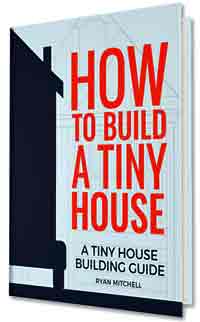 makes a great design, areas people make common mistakes, and how to make a house a home.
makes a great design, areas people make common mistakes, and how to make a house a home.
This is a step-by-step guide to determine what design is right for you, avoid mistakes, and make tough decisions simple. Understand what needs to be in your house and more importantly, what shouldn’t take up precious space. Click on image to order.
How To Build A Tiny House
The book is 245 pages filled with custom color graphics showing each step of the building process. In this book, Ryan Mitchell shows you how building techniques and design interact, how to confidently build a quality house, and determine a design that’s right for you. This guide is specifically designed for those who have zero experience. Mitchell wrote this to help you know what questions to ask and give you the base knowledge on how to build. Click on image to order.
Tiny House Utilities
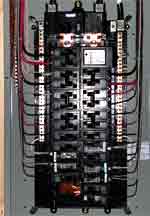
Electrical Wiring
Does your blood run cold when you look at the picture of a basic home electrical panel like the one shown here? Maybe it should. 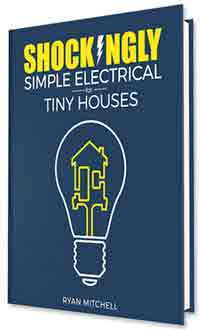 There’s some stuff in there that can kill you if you’re not careful. Adding solar panels makes it even more complex. While I personally feel comfortable wiring the outlets, I call an electrician to make the final connections in the panel and sign off on the project. The building inspector is satisfied with this approach too.
There’s some stuff in there that can kill you if you’re not careful. Adding solar panels makes it even more complex. While I personally feel comfortable wiring the outlets, I call an electrician to make the final connections in the panel and sign off on the project. The building inspector is satisfied with this approach too.
Shocking Simple Electrical book
There are a lot of electrical guides out there, but this is the only one that speaks to tiny houses specifically. There are some things about tiny houses that are unique, and he explains how a tiny house is different and everything you need to consider along the way.
Understand the basic theory of how to design an electrical system perfect for your tiny house. In this ebook, he goes beyond simple instructions and delves into the ‘why’ behind each choice. Starting at the very beginning, he explains everything in easy to understand terms. Click on image to order.
Solar Systems May Seem Complex
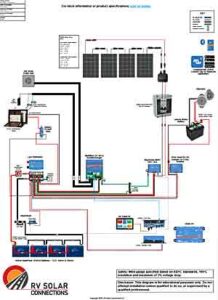
First, determine the optimal size of your battery bank and solar array (based on your specific power needs). From there, create your custom wiring diagram. You might need a professional to help with this. The folks at RV Solar Connections will help you create the perfect system and even get you in touch with a professional installer near you.
Demystify your mobile electrical system with a customized RV solar wiring diagram. Their diagrams include every component, wire and fuse to clearly show how the pieces of the puzzle come together.
DIY electrical upgrades have never been easier with the help of an RV Solar Connections custom wiring diagram. Take guesswork out of the equation and ensure your off grid electrical system is safe, efficient, and fully functional.
Heating and cooling
Tiny house heating and cooling requirements seem to be the most misunderstood and neglected of the dwelling’s infrastructure.
Tiny home social pages and blogs are full of comments from desperate tiny home dwellers dealing with moisture and mold issues. Freezing water pipes and propane problems run a close second during winter months.
Air Quality
Tiny homes have unique air quality problems because they are built so tight. Larger homes can dissipate moisture and have enough oxygen for the normal family. Tiny homes will need to dehumidify and add replacement air via such devices as an HRV. An HRV will require some duct work to be installed.
A Heat Recovery Ventilator will bring in fresh air and vent moisture without losing your heat. They can be expensive, but should be included in every tiny house HVAC system. At the very least you’ll need fresh air intake and an exhaust fan.
If you have a gas cook top you’ll need venting to prevent carbon monoxide buildup.
Skirting

Skirting for your tiny home is much more than a cosmetic feature. Adapted from the mobile home industry, skirting helps insulate your tiny home by creating a wind barrier to the underside of your home. Your heating and cooling systems will be more efficient, saving you money. If you’ll be staying in one place for a long time, consider adding skirting to your tiny home. Skirting is required by law in some places. Visit this page of the website for more details on skirting.
More Tiny Home Infrastructure
Off Grid Living In A Tiny House
Calculating the Weight Of Your Tiny House
Best way to insulate a tiny house
Best Ways To Heat Your Tiny Home


